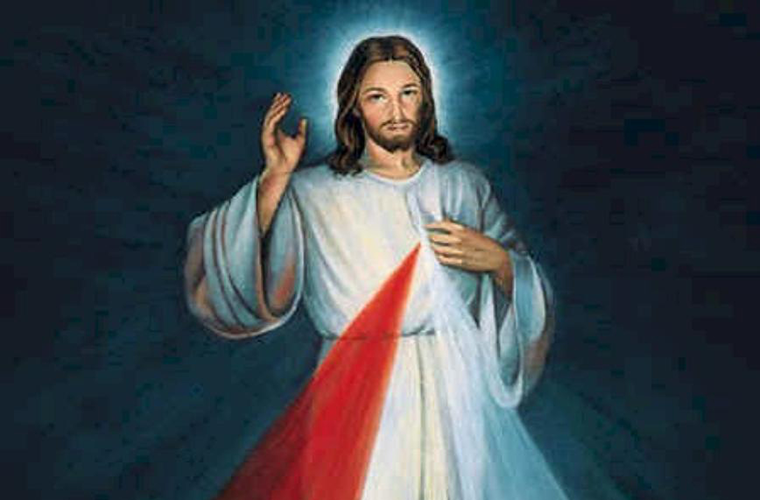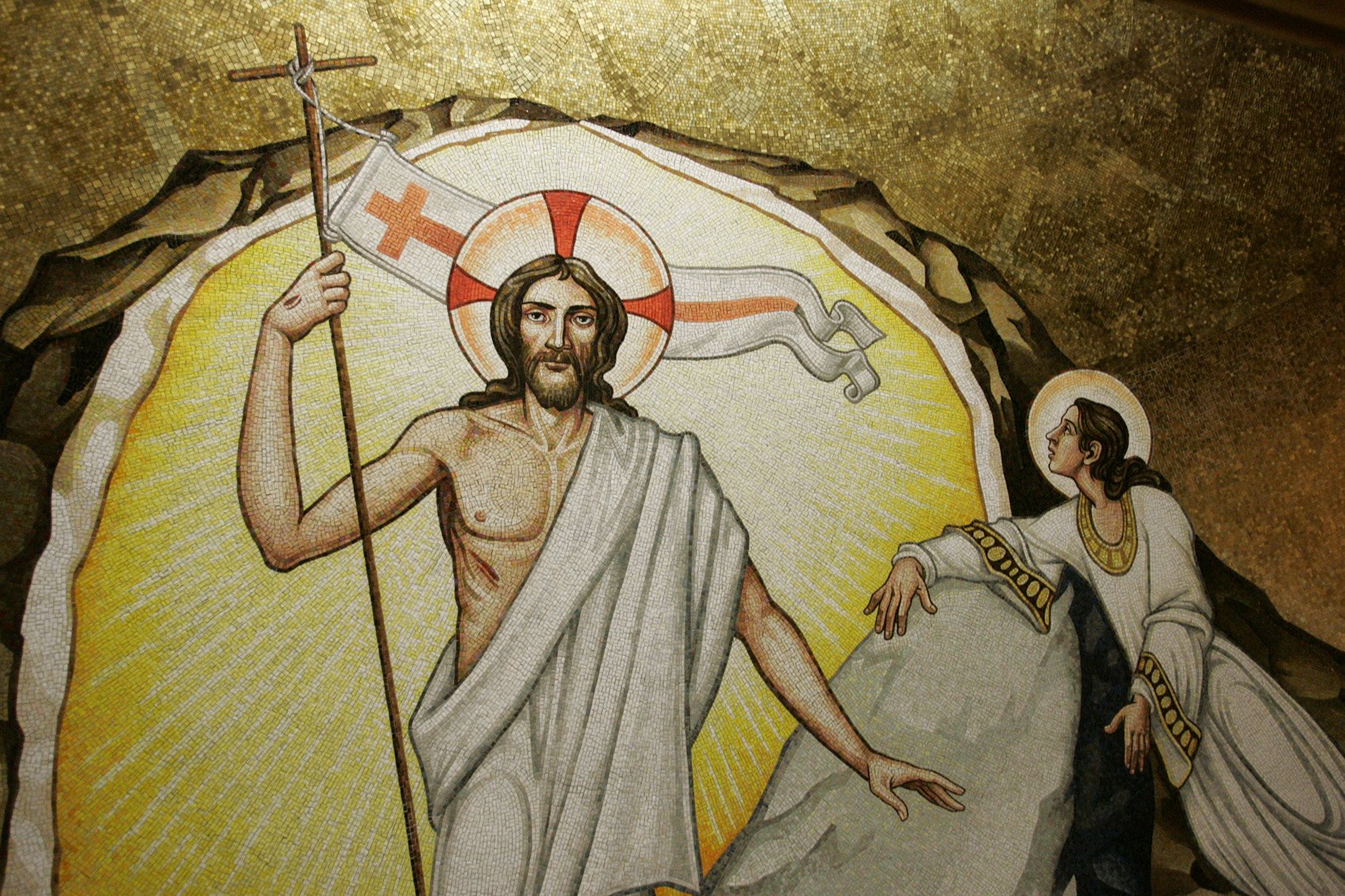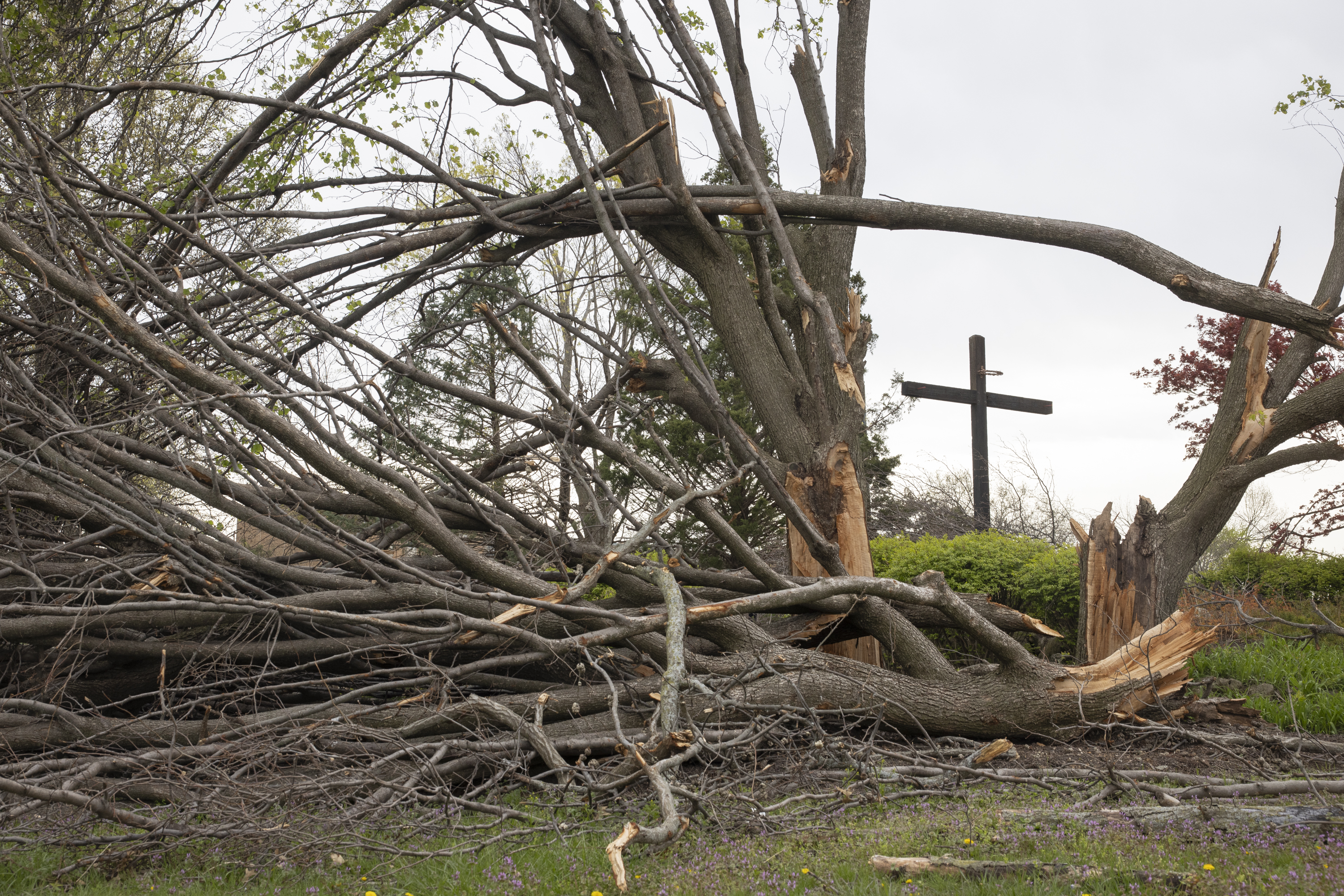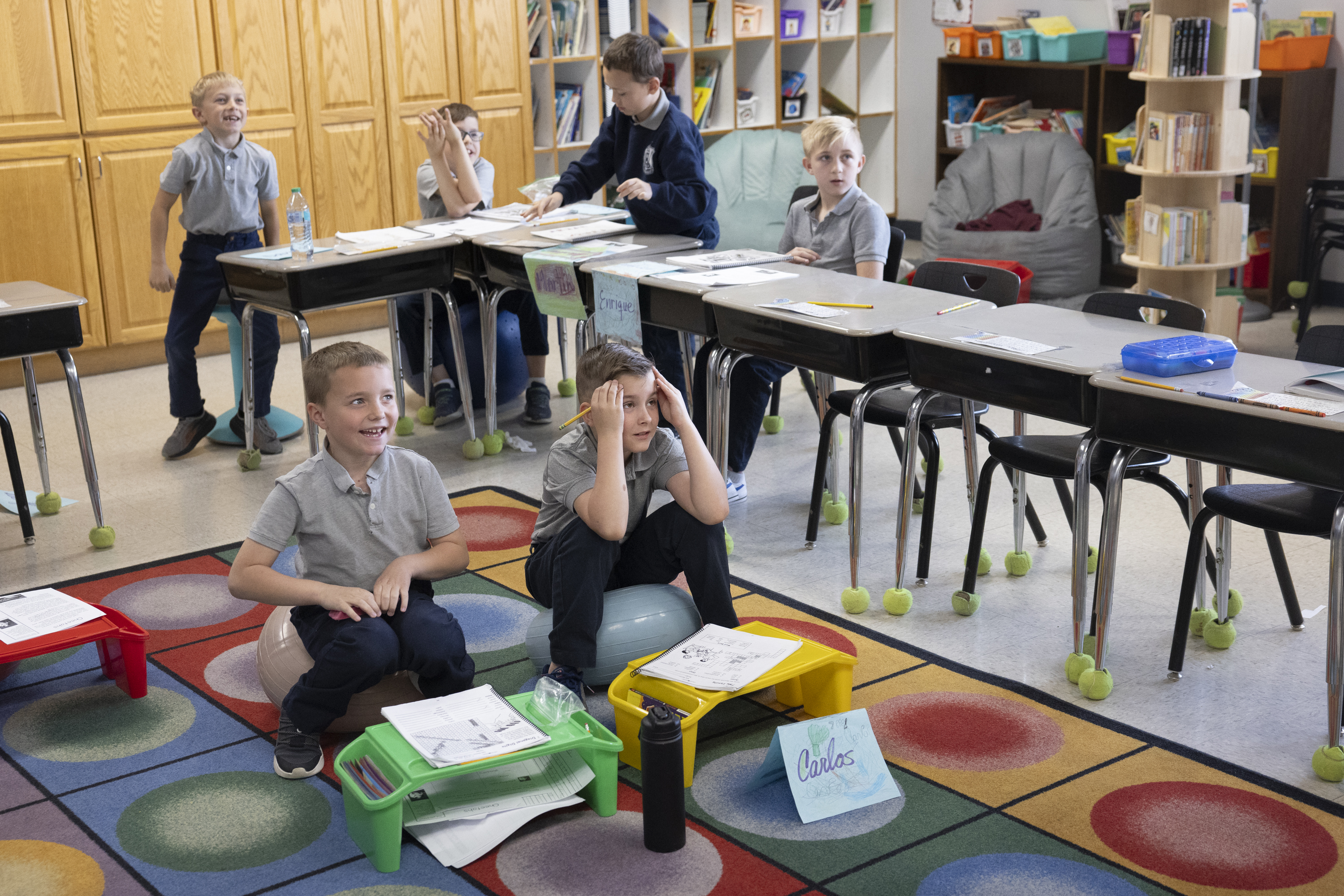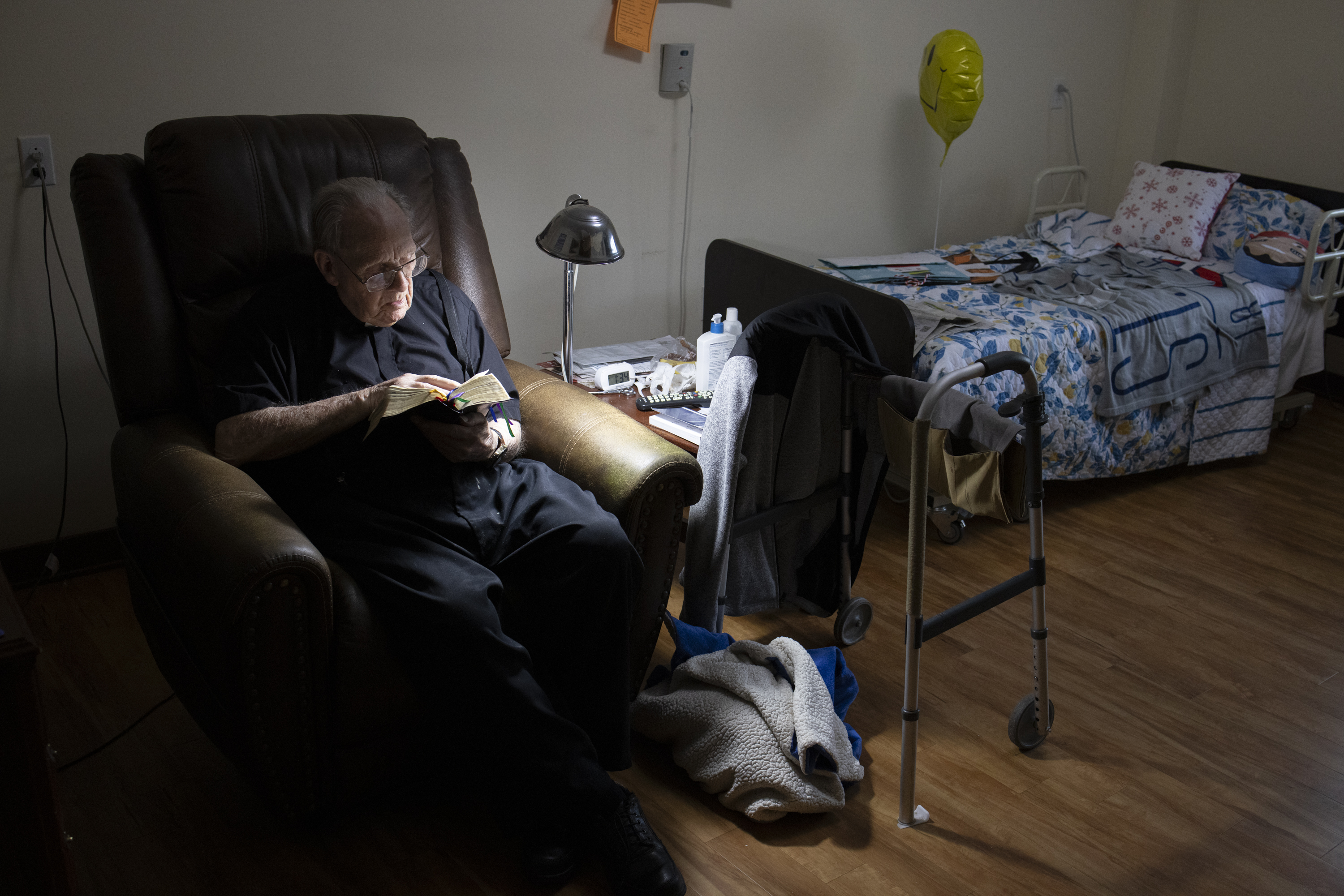Angel of Harmony sculpture restoration in progress after vandalism outside cathedral basilica

Original sculptor Wiktor Szostalo is repairing the damage done to the stainless steel figures
At age 72, Wiktor Szostalo is impressively spry as he scrambles up the custom welded scaffolding surrounding his stainless-steel sculpture.
He flips his welding mask down, then turns his plasma cutter to the angel’s right wing, sparks arcing through the air as he reshapes the structure, bit by bit. More than 100 wind chimes dangle from the wings, waiting to be straightened and rearranged to make music again.
“You can see the top of this wing, with the long tubes — they are pulled this way, and normally, the whole day, they were hanging straight,” Szostalo said. “If their tops are pulled toward us, they will start hanging again.”
Szostalo is deep in the effort to repair his 1999 Angel of Harmony sculpture for the Cathedral Basilica of Saint Louis after it was damaged in September by a man tampering with construction equipment. Police found a boom lift had been dropped onto the 11-foot sculpture, knocking it off its pedestal. They arrested a 35-year-old man in connection with the vandalism.
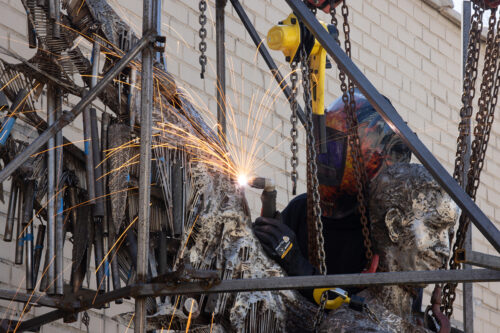
The sculpture depicts an angel with African-American features and large wind-chime wings. In front of the angel are three children with Hispanic, Asian and European features playing a hymn of peace on different instruments.
The base, made of black African granite, includes quotes from the New Testament, St. John Paul II and Dr. Martin Luther King Jr. Then-Auxiliary Bishop Edward K. Braxton had suggested the statue to Archbishop Justin F. Rigali; it was a gift from Adelaide Schlafly in memory of her late husband, Daniel.
The statue emphasizes a “theme of harmony, peace and racial justice,” Bishop Braxton said at the time. “The African-American features will depart from traditional images of angels with European features in order to emphasize the universality of God’s love for all people.”
Szostalo received the damaged sculpture at his Granite City, Illinois, studio around Christmastime. The head of the boy with the drum was nearly torn off, and his torso was deformed. The legs of the sitting girl were also twisted. The angel’s wings were damaged, bent badly out of shape, with the wind chimes dented and sticking out in all directions.
Szostalo also has to repair the twisted steel base of the sculpture. Previously, someone had broken off the small dove inside the bell the girl holds; Szostalo is taking the opportunity to restore that, too.
By late February, the boy with the drum and the sitting girl had been repaired and were sitting safely inside Szostalo’s studio, ready to be reattached to the rest of the sculpture. Once the figures are assembled together, grinding and polishing will be last, returning the sculpture as closely as possible to its original form. The work is scheduled to be completed this spring.
Polish protester to celebrated sculptor
How did a Polish Solidarity Movement leader-turned-political-refugee become a go-to sculptor of African-American inspired art?
Szostalo’s father was a theologian who worked alongside Blessed Father Michael Sopoćko, St. Faustina Kowalska’s confessor, and was involved in translating the Divine Mercy writings from Polish to Latin. He read young Wiktor stories of saints every night and also recounted stories of how he and Father Sopoćko helped smuggle Jews out of the Vilnius ghetto during the Holocaust.
That nurtured Szostalo’s love for his faith, justice and those who are marginalized, he said.
“My dad risked his life for two years doing that, so that was a big inspiration for me to both get involved in the pro-democracy movement and also religious art,” he said.
Szostalo came to the U.S. as a political refugee in the early 1980s after spending six months in jail for his role in the pro-democracy movement in then-communist Poland. His first work in St. Louis was as a translator for the International Institute. There, he got to know some Polish nuns in the archdiocese, who learned that he was an artist, having earned a degree in painting and sculpture from the Academy of Fine Arts in Krakow. They told him that St. Simon Parish in south St. Louis County wanted to commission a sculpture of its patron.
His next project was a sculpture of St. Martin de Porres, a 16th-century saint of African and Spanish heritage, for St. Alphonsus Ligouri “Rock” Church in St. Louis. Szostalo went looking for inspiration for Afro-centric religious artwork, visiting several churches in the surrounding area — but didn’t have any luck, eventually turning instead to a Black model for the project.
His St. Martin de Porres was well-received when it was finished, so he made a miniature version to show at a national conference for historically Black parishes. On the first day, he sold out of everything.
“That’s how I spent the next eight, nine years hardly doing anything else but religious art for Black churches,” he said, adding that he got to know many of the African-American bishops that way, too, including Bishop Braxton.
“Bishop Braxton calls me and said, ‘Wiktor, could you come up with something that’s actually Afro-centric for the Cathedral?’ He looked around and didn’t find anything,” Szostalo said.
The Angel of Harmony took him about a year to make, with the help of an assistant. He worked around the clock for several months, only sleeping every other night, he said. It was installed on the lawn next to the cathedral basilica in June 1999.
When Szostalo learned of the statue’s vandalism last fall, his reaction was less anger and more concern for the man involved who seemed to be acting erratically, he said.
“I was really very moved and somewhat surprised at the response to the vandalism of the sculpture,” he said, citing the widespread coverage of the incident in news outlets around the country and in Poland. “It was an interesting test of, in a mental sense, of art and commitment to these ideas the sculpture expresses. And I see that commitment is there, and that’s great. Is everything perfect? No, of course not. But it’s a symbol of all the good that’s in us, and let’s keep our efforts (going) further,” he said.
The repair of the sculpture can be encouragement for all of us, he said. “Even the attempts at creating harmony may be attacked; maybe there will be folks trying to interrupt it, but we just get up and move on.”
Angel of Harmony base inscriptions
“Blessed are the merciful, for they shall obtain mercy. Blessed are the pure of heart; for they shall see God. Blessed are the peacemakers; for they shall be called children of God.” — Matthew 5:7-9
“Love is the only force capable of transforming an enemy into a friend.” — Dr. Martin Luther King Jr.
“American will remain a beacon of freedom for the world as long as it stands by those moral truths which are at the very heart of its historical experience. And so, America, if you want peace, work for justice. If you want justice, defend life. If you want life, embrace the truth revealed by God.” — Pope John Paul II, St. Louis, January 27, 1999
Original sculptor Wiktor Szostalo is repairing the damage done to the stainless steel figures
Subscribe to Read All St. Louis Review Stories
All readers receive 5 stories to read free per month. After that, readers will need to be logged in.
If you are currently receive the St. Louis Review at your home or office, please send your name and address (and subscriber id if you know it) to subscriptions@stlouisreview.com to get your login information.
If you are not currently a subscriber to the St. Louis Review, please contact subscriptions@stlouisreview.com for information on how to subscribe.



